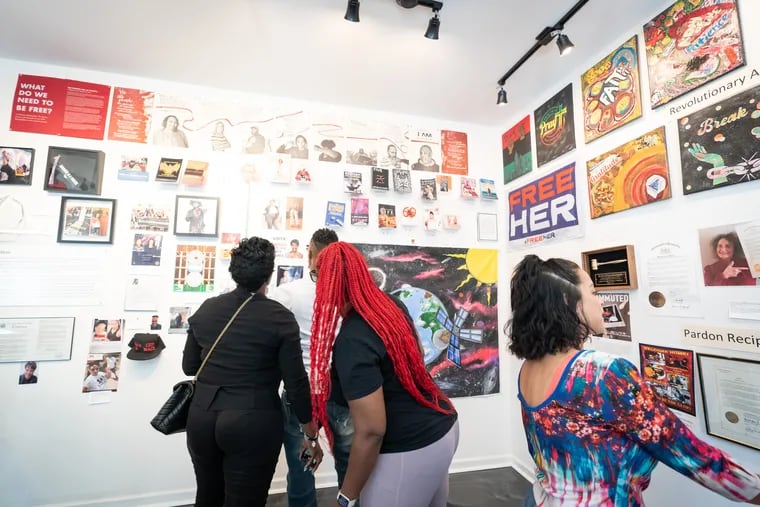
Museums and exhibits have long explored the experience of incarceration, from Eastern State Penitentiary to the National Museum of African American History and Culture. But the people behind a new Philadelphia museum believe that they have opened the first that honors people for what they’ve done since leaving prison.
On Friday morning, the East Germantown nonprofit Why Not Prosper hosted a ribbon-cutting event for the Formerly Incarcerated Renaissance Museum (FIRM). The museum, located in a separate building behind Why Not Prosper at 717 E. Chelten Ave., honors the experiences, artwork, and activism of people who have been imprisoned.
The museum will be open Monday, Wednesday and Friday, from 10 a.m. to 3:30 p.m. The cost of admission is a suggested $11 donation, though no one will be turned away if they can’t pay.
“We are not our mistakes. We are so powerful.”
The Rev. Michelle Simmons, the founder of Why Not Prosper, said that as her organization celebrates its 23rd anniversary this month, it was time to think about the legacy she and Why Not Prosper would leave. Simmons was formerly incarcerated herself and started the organization to empower other women as they transition from prison to become self-sufficient and contributing members of their communities.
She said she hopes that when people visit the FIRM, they come away with more awareness of what incarcerated people experience and new insight into how they can be valuable members of society if they’re given the chance. Featuring artwork and books by formerly incarcerated people, artifacts from prison life, and exhibits honoring activists fighting to improving life for current and formerly incarcerated people, the FIRM is designed to be unlike any traditional museum.
“We are not our mistakes. We are so powerful. We’re so inspirational. We’re so knowledgeable,” she said.
‘Feels like freedom’
Simmons began her museum project by convening an arts council made up of formerly incarcerated women from across the country. They created a contest for current and formerly incarcerated people to submit artwork to be featured in the museum, and those people spread the information to their personal networks.
They received an overwhelming number of submissions, and more are still coming in. Now, the FIRM has artwork or exhibits representing people from 22 states, including visual art, books, clothing, and stories of business owners and award winners.
“I have a khimar of a young lady, she says, ‘this is the only piece of garment they couldn’t strip from me,’” Simmons said. “I have a crown from a young man who was sentenced to die at 15, and now he’s home and he is the king of one of the villages in Ghana.”
But with so many items coming in, they needed to be pieced together in a way that told the narrative of incarcerated people that Simmons had envisioned. In came Monica O. Montgomery — a museum leader, independent curator, and former University of the Arts professor — who works at the intersection of art, history, and social justice.
Montgomery read a call for submissions to the museum in the Germantown Info Hub and was inspired by the project. She reached out to Simmons and offered to help.
“I feel very deeply connected to people who have been marginalized and oppressed. And I’m never far from that,” Montgomery said. “Even though I’m a professor and a curator and a consultant, I always want to represent for my people. I always want to do things to uplift the community and this is my way of giving back.”
They decided to divide the museum into four sections. It begins with Foundation, a celebration of Simmons, the work she has done for over two decades, and the honors she’s received. Next is Incarceration, giving insight to what being locked up is like and how it impacts a person. Then there is Inspiration, telling stories of what people have done after their release, and finishing with Revolution, which shows the arts and activism people have done to advocate for others currently and formerly incarcerated.
Some of Montgomery’s favorite pieces in the museum include an array of awards Simmons has received over the years, exhibits highlighting the work of advocates in Boston and Oakland, Calif., and a large art piece called The Guardian by a currently incarcerated artist, James Green, which shows a Black woman flying through a blue sky.
“It just feels like freedom,” Montgomery said.
The museum building was once a storage space for Why Not Prosper until lead artist Michael “OG Law” Ta’Bon transformed its exterior.
Ta’Bon spent more than a decade in prison, and since his release in 2006, he’s become an accomplished artist and activist committed to violence prevention and prison reform. He was featured in the 2020 film Concrete Cowboy opposite Idris Elba and uses interactive exhibits with shock value to convey his messages.
“Some people just feel like when you do a crime, you don’t serve second chances or don’t believe that you can really make a positive effect on the world,” he said.
Ta’Bon also created a mural directly across from the FIRM with the help of other formerly incarcerated artists on the back of Why Not Prosper’s building. It shows a Black woman running along a winding golden road, carrying a torch that’s been handed to her by Simmons. Even though the woman in the mural is now free, bars cover her path and she is still breaking out of her shackles.
This post was originally published on this site be sure to check out more of their content.






